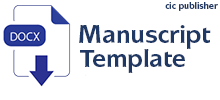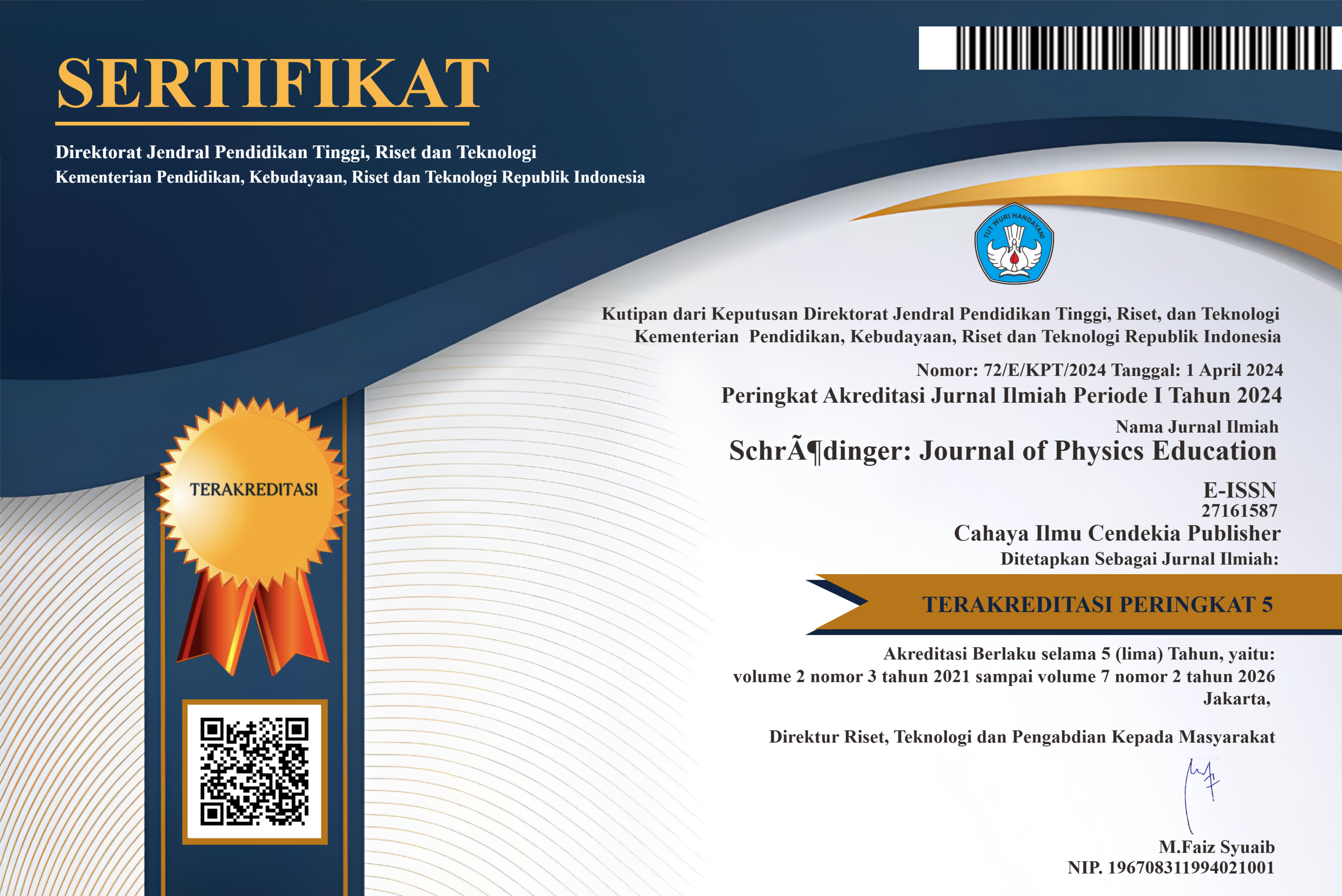Analysis of Physics Students' Conceptual Understanding of Image Formation in Lenses
Abstract
Purpose of the study: This research aims to analyze physics students' understanding of the concept of image formation in lenses.
Methodology: This method uses qualitative methods with a research design, namely documentation studies, data collection instruments using interview sheets with data analysis techniques, namely the Miles and Huberman technique.
Main Findings: Based on the research results, it can be seen that the level of students' conceptual understanding of image formation is increasing. This is shown by the number of student respondents who answered correctly during the written test, the number increased during the interview test and the average number of respondents who answered correctly was more than half of the total number of respondents. The increase in understanding of this concept occurred because the student respondents were better prepared when taking the interview test than when taking the written test. The respondent students were better prepared because the respondents' memories were revived after the written test.
Novelty/Originality of this study: This innovative approach not only highlights the importance of active learning strategies in education but also underscores the potential of sequential testing to foster deeper conceptual understanding among students.
References
R. Nurmalasari, R. Dian, P. Wati, P. Puspitasari, W. Diana, and N. K. Dewi, “55-Riana-Nurmalasari-Reta-Dian-Purnama-Wati-Poppy-Puspitasari,” pp. 722–733, 2013.
S. Ineu, M. Teni, H. Yadi, H. H. Asep, and Prihantini, “Analisis Implementasi Kurikulum Merdeka Belajar di Sekolah Penggerak,” J. basicedu, vol. 6, no. 5, pp. 8248–8258, 2022.
E. Sulistiani and Masrukan, “Pentingnya Berpikir Kritis dalam Pembelajaran Matematika untuk Menghadapi Tantangan MEA,” Semin. Nas. Mat. X Univ. Semarang, pp. 605–612, 2016.
S. W. Oktavia, H. Mansur, and M.Hidayat, “Investigasi Keterampilan Mengajar Guru Fisika di SMA N 9 Kerinci,” J. Relativ., vol. 6, no. 1, pp. 24–30, 2023.
S. W. Octavia, N. Septiani, F. Sinaga, and N. N. Qoidah, “Analysis Of The Relationship In Learning Interest To Learning Outcomes Static Fluid Material In Senior High School,” J. Ilm. Ilmu Terap. Univ. Jambi, vol. 7, no. 1, pp. 31–41, 2023, doi: 10.22437/jiituj.v7i1.26696.
N. J. Alsaleh, “Teaching Critical Thinking Skills : Literature Review,” Turkish Online J. Educ. Technol., vol. 19, no. 1, pp. 21–39, 2020.
W. A. Putri, A. Astalini, and D. Darmaji, “Analisis Kegiatan Praktikum untuk Dapat Meningkatkan Keterampilan Proses Sains dan Kemampuan Berpikir Kritis,” Edukatif J. Ilmu Pendidik., vol. 4, no. 3, pp. 3361–3368, 2022, doi: 10.31004/edukatif.v4i3.2638.
N. Nada, H. Mustapa, Nur Kholija Harahap, and S. W. Oktavia, “Analysis Of Emotional Intelligence On Science Learning Achievement,” EduFisika, vol. 8, no. 3, pp. 261–267, 2023, doi: 10.59052/edufisika.v8i1.24864.
W. A. Pratama, S. Hartini, and Misbah, “Analisis Literasi Digital Siswa Melalui Penerapan E-Learning Berbasis Schoology,” J. Inov. dan Pembelajaran Fis., vol. 06, no. 1, pp. 9–13, 2019.
Aziz, A. Fauzan, F. I. Putri, and M.Yudis, “Perbandingan Minat Belajar Ipa Fisika Siswa Pada Dua Kelas Di Pondok Pesantren,” J. Kependidikan, vol. 15, no. 1, pp. 26–37, 2021.
N. Nursyamsiah, “Minat Belajar dan Kemandirian Belajar Siswa terhadap Kreativitas Belajar Sejarah Siswa Kelas X IPS MAN 1 Kabupaten Sarolangun,” Indones. J. Educ. Res., vol. 3, no. 3, pp. 57–61, 2022, doi: 10.37251/ijoer.v3i3.562.
Samijo and D. D. Romadona, “A Study of Science Process Skills on Simple Pendulum Materials,” SchrödingerJournal Phys. Educ., vol. 4, no. 1, 2023, doi: 10.37251/sjpe.v4i1.494.
E. A. Adekanye, “The use of electronic media by students of Yaba College of Technology, Lagos State, Nigeria: A qualitative study,” J. Libr. Serv. Technol., vol. 5, no. 3, pp. 1–16, 2023, doi: 10.47524/jlst.v5i3.2.
G. Mc Pherson-Geyser, R. de Villiers, and P. Kavai, “The use of experiential learning as a teaching strategy in life sciences,” Int. J. Instr., vol. 13, no. 3, pp. 877–894, 2020, doi: 10.29333/iji.2020.13358a.
M. Nasir, C. Cari, W. Sunarno, and F. Rahmawati, “The effect of STEM-based guided inquiry on light concept understanding and scientific explanation,” Eurasia J. Math. Sci. Technol. Educ., vol. 18, no. 11, 2022, doi: 10.29333/ejmste/12499.
M. Sailer, F. Schultz-Pernice, and F. Fischer, “Contextual facilitators for learning activities involving technology in higher education: The C♭-model,” Comput. Human Behav., vol. 121, no. October 2020, p. 106794, 2021, doi: 10.1016/j.chb.2021.106794.
A. Alenezi, “The role of e-learning materials in enhancing teaching and learning behaviors,” Int. J. Inf. Educ. Technol., vol. 10, no. 1, pp. 48–56, 2020, doi: 10.18178/ijiet.2020.10.1.1338.
D. C. Edelson et al., “Developing Research-Based Instructional Materials to Support Large-Scale Transformation of Science Teaching and Learning: The Approach of the OpenSciEd Middle School Program,” J. Sci. Teacher Educ., vol. 32, no. 7, pp. 780–804, 2021, doi: 10.1080/1046560X.2021.1877457.
E. Kuswanto, “Peranan Guru PAI dalam Pendidikan Akhlak di Sekolah,” MUDARRISA J. Islam. Educ., vol. 6, no. 2, p. 194, 2015, doi: 10.18326/mdr.v6i2.194-220.
D. Desilva, I. Sakti, and R. Medriati, “Pengembangan Instrumen Penilaian Hasil Belajar Fisika Berorientasi Hots (Higher Order Thinking Skills) Pada Materi Elastisitas Dan Hukum Hooke,” J. Kumparan Fis., vol. 3, no. 1, pp. 41–50, 2020, doi: 10.33369/jkf.3.1.41-50.
S. Saharuddin and M. Wahab, “Analisis Kesulitan Dalam Pemebelajaran Ipa Di Smp Negeri Limboro,” J. IPA Terpadu, vol. 2, no. 2, pp. 75–83, 2019, doi: 10.35580/ipaterpadu.v2i2.11148.
U. Ulfa, E. Saptaningrum, and A. F. Kurniawan, “Pengaruh Model Discovery Learning Pada Mata Pelajaran IPA Terpadu Terhadap Penguasaan Literasi Sains Siswa,” Pros. SNFA (Seminar Nas. Fis. dan Apl., vol. 2, no. 2, p. 257, 2017, doi: 10.20961/prosidingsnfa.v2i0.16408.
F. A. Farid Samsu Hananto, “Optimalisasi Tegangan Keluaran Dari Solar Cell Menggunakan Lensa Pemfokus Cahaya Matahari,” J. Neutrino, 2012, doi: 10.18860/neu.v0i0.1934.
V. N. VAN HARLING, “Pengaruh Variasi Jumlah Lensa Terhadap Volume Air Tawar Yang Dihasilkan Dari Alat Penyulingan Air Laut Menggunakan Lensa Cembung,” J. Voering, vol. 2, no. 1, p. 43, 2017, doi: 10.32531/jvoe.v2i1.53.
R. Riwayani, R. Perdana, R. Sari, J. Jumadi, and H. Kuswanto, “Analisis kemampuan argumentasi ilmiah siswa pada materi optik: Problem-based learning berbantuan edu-media simulation,” J. Inov. Pendidik. IPA, vol. 5, no. 1, pp. 45–53, 2019, doi: 10.21831/jipi.v5i1.22548.
M. R. A. Taqwa, “Profil Pemahaman Konsep Mahasiswa dalam Menentukan Arah Resultan Gaya,” Pros. Semin. Nas. Pendidik. Sains, no. January 2017, pp. 79–87, 2017.
M. John, J. M. Molepo, and M. Chirwa, “South African learners’ conceptual understanding about image formation by lenses,” Eurasia J. Math. Sci. Technol. Educ., vol. 13, no. 6, pp. 1723–1736, 2017, doi: 10.12973/eurasia.2017.00694a.
W. S. Peacarson, “The mediating effects of student beliefs on engagement with written feedback in preparation for high-stakes English writing assessment,” Assess. Writ., vol. 52, no. January, p. 100611, 2022, doi: 10.1016/j.asw.2022.100611.
X. C. Cravens and S. B. Hunter, “Assessing the impact of collaborative inquiry on teacher performance and effectiveness,” Sch. Eff. Sch. Improv., vol. 32, no. 4, pp. 564–606, 2021, doi: 10.1080/09243453.2021.1923532.
A. S. Alanazi, A. A. Almulla, and M. A. S. Khasawneh, “Evaluating the Effects of Integrating Cognitive Presence Strategies on Teacher Attitudes and Student Learning Outcomes in Special Education and Autism Classrooms,” Int. J. Spec. Educ., vol. 38, no. 2, pp. 80–89, 2023, doi: 10.52291/ijse.2023.38.24.
G. W. Wright and S. Park, “The effects of flipped classrooms on K-16 students’ science and math achievement: a systematic review,” Stud. Sci. Educ., vol. 58, no. 1, pp. 95–136, 2022, doi: 10.1080/03057267.2021.1933354.
Amirotun Sholikhah, “Statistik Deskriptif Dalam Penelitian Kualitatif,” Komun. Islam, vol. 10, no. No. 2 (2016), pp. 1–21, 2016.
H. Subekti and D. N. Qomariyah, “Analisis Kemampuan Berpikir Kreatif: Studi Eksplorasi Siswa Di Smpn 62 Surabaya,” Pensa E-Jurnal Pendidik. Sains, vol. 9, no. 2, pp. 242–246, 2021.
Nurdin, D. Hamdhana, and M. Iqbal, “Aplikasi Quick Count Pilkada Dengan Menggunakan Metode Random Sampling Berbasis Android,” e-Journal Techsi Tek. Inf., vol. 10, no. 1, pp. 141–154, 2018.
M. Smachew, M. F. Melak, A. Atenafu, and A. K. Belew, “Lifestyle Modification Practice and Associated Factors Among Diagnosed Hypertensive Patients in Selected Hospitals in Central Gondar Zone,” Nutr. Metab. Insights, vol. 15, 2022, doi: 10.1177/11786388221088245.
M. Sholihah and N. Amaliyah, “Peran Guru Dalam Menerapkan Metode Diskusi Kelompok Untuk Meningkatkan Keterampilan Berpikir Kritis Siswa Kelas V Sekolah Dasar,” J. Cakrawala Pendas, vol. 8, no. 3, pp. 898–905, 2022, doi: 10.31949/jcp.v8i3.2826.
A. Astalini, D. A. Kurniawan, and S. Sumaryanti, “Sikap Siswa Terhadap Pelajaran Fisika di SMAN Kabupaten Batanghari,” JIPF (Jurnal Ilmu Pendidik. Fis., 2018, doi: 10.26737/jipf.v3i2.694.
Astalini, Darmaji, D. A. Kurniawan, S. W. Oktavia, E. Triani, and M. Z. Azzahra, “The Exploration of Character Values in Physics Learning on Momentum, Impulse, and Collision Materials,” J. Educ. Res. Eval., vol. 7, no. 2, pp. 277–284, 2023, doi: 10.23887/jere.v7i2.52381.
W. Nugraheni, “Peningkatan Kemampuan Mendeskripsikan Proses Pembentukan Bayangan Melalui Media Animasi Pada Siswa Kelas Viii-G Smpn 1 Puncu,” J. Penelit. Pendidik. IPA, vol. 3, no. 2, p. 77, 2019, doi: 10.26740/jppipa.v3n2.p77-81.
Nirsal, “Perangkat Lunak Pembentukan Bayangan pada Cermin dan Lensa,” J. Ilm. d’Computare, vol. 2, no. 1, pp. 24–33, 2019.
E. Andriana, T. Djudin, and S. B. Arsyid, “Remediasi Miskonsepsi Pembiasan Cahaya Pada Lensa Tipis Menggunakan Direct Instruction Berbantuan Animasi Flash Sma,” J. Pendidik. dan Pembelajaran, vol. 3, no. 1, pp. 1–11, 2019.
Rizal, “Perangkat pengukur rabun jauh dan rabun dekat pada mata berbasis mikrokontroler,” no. June, pp. 90–97, 2014.
V. D. Sekerin, M. N. Dudin, A. E. Gorokhova, V. I. Gayduk, and V. I. Volkov, “Creation of a Virtual Image: Digital Technology of the 21st Century,” Amaz. Investig., vol. 8, no. 20, pp. 340–348, 2019.
A. S. Anhar, I. D. Sara, and R. H. Siregar, “Desain Prototype Sel Surya Terkonsentrasi Menggunakan Lensa Fresnel,” J. Online Tek. Elektro, vol. 2, no. 3, pp. 1–7, 2017.
J. Uwamahoro, K. Ndihokubwayo, M. Ralph, and I. Ndayambaje, “Physics Students’ Conceptual Understanding of Geometric Optics: Revisited Analysis,” J. Sci. Educ. Technol., vol. 30, no. 5, pp. 706–718, 2021, doi: 10.1007/s10956-021-09913-4.
Copyright (c) 2024 Wahyu Noor Hidayat, Ronno C. K, Jhon Alfredo Silva Alé

This work is licensed under a Creative Commons Attribution 4.0 International License.
Authors who publish with this journal agree to the following terms:
- Authors retain copyright and acknowledge that the Schrödinger: Journal of Physics Education is the first publisher licensed under a Creative Commons Attribution 4.0 International License.
- Authors are able to enter into separate, additional contractual arrangements for the non-exclusive distribution of the journal's published version of the work (e.g., post it to an institutional repository or publish it in a book), with an acknowledgment of its initial publication in this journal.
- Authors are permitted and encouraged to post their work online (e.g., in institutional repositories or on their website) prior to and during the submission process, as it can lead to productive exchanges and earlier and greater citation of published work.







.png)
.png)








.png)
.png)
.png)







